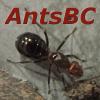1. Fish creek park.
2. April second.
3. Forested area. Mostly poplar with pines up the ridge
4. 14mm
5. Black, shiny, smooth, 4 hair bands on the abdomen slight purple colour almost in the thorax and in bands on the abdomen
7. Sluggish but got really fast once they warmed up. Scattered everywhere.
8. Under the bark of a rotting poplar tree. Was only one chambers. Only just under the bark.
[img]
 [img]
[img][img]
 [img]
[img]1. Exact same as above
2. Same as above
3. Exact same as above
4. Length. Can’t get it. She is all curled up
5. Same as above
6. Asleep.
7. Same as above
8. Same as above
[img]
 [img]
[img][img]
 [img]
[img]Where found not even two feet of each other. Mistook the large ant in the asleep queens chamber as the queen. Then freaked out when I found the real queen as she was HUGE!
Edit: as they have workers and larva etc would I add an out world?
Edited by DrygonKing, April 2 2019 - 6:16 PM.
























